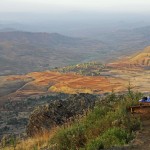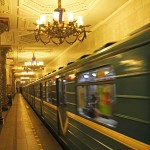Lhasa, Tibet – Local Residents 30 years ago (10.01.15)
One of the greatest aspects of being an international traveller – in whatever capacity – is that you begin to understand and engage with the people and culture you are visiting. With understanding comes the loss of fear and with the loss of fear, the ability to embrace whatever culture you are thrown into.

Lhasa Old Town – 1985
This week, as the world watched the Charlie Hebdo atrocity unfold, we have seen a tragic example of how damaging the polar opposite of ‘understanding, engaging and embracing’ another person’s creed, culture and conviction can be.
Whatever one’s religious, political or moral views, there is no doubt the young terrorists could have done with, among many other things, some seriously extended periods of international travel. Time spent travelling would have mellowed their outlook on life, as well as probably enhanced their belief in tolerance and non-violence.
The world champion of non-violence is arguably the Dalai Lama, spiritual leader of the Tibetan people, who has continuously advocated that the Tibetan people’s cause should be represented through non-violence.
In the light of the Paris killings I would therefore like to focus this week on a city where two very different cultures who live side-by-side far away from Europe or Arabia. A city where two sets of hugely differing people have had to live with the constant shadow of non-violence, as well as violence, filtering into their everyday lives.
The people of central Lhasa, Tibet.

Admirable though the Dalai Lama’s non-violence teaching has been, the world has often played lip service to a leader so adamant in his pacifist beliefs. The Pope recently declined to meet the Tibetan leader, and South Africa refused to offer him a visa to the Nobel peace summit in Cape Town – both for fear of falling out with the Chinese, who remain omnipresent and authoritarian in Tibet.
Perhaps with recent events the world will appreciate the Tibetan spiritual leader’s pacifists teaching more?
Resident Tibetans have been unable to receive their spiritual leader since 1959 when he was exiled after the Tibetan Revolution. In this time the city of Lhasa has remained one of the world’s remotest, yet most exciting, capitals. Located at 3,490m, the mystical Potala Palace, Jokhang Temple and Noborbulingka palaces continue to dominate the traditional centre of town.

I first visited Tibet thirty years ago (Ref’ my previous blog posting ‘Tibet Yesterday – Travel Photography Today’). In all the years since then, while Nomadic Thoughts has arranged travel to this region of China, I have always held a candle for the people of Lhasa, and in particular those who have lived in the heart of the city. A frisson of spiritual activity continues to spill onto the streets as rural folk mix with both indigenous Tibetans and now well-established Chinese immigrants. While politicians, priests, police and pacifists have struggled with the changing environment, the people of Lhasa have had to make a living in an environment constantly under threat from two such radically different sets of customs and political and religious beliefs.
As Nomadic Thoughts continues to arrange client travel to this special region of the Himalayas, and in light of the disregard for non-violence this week, I am posting these photos of people living, working and sharing their lives in and around central Lhasa. I took all these images in 1985 as the local Tibetan and Chinese Lhasa residents began to embrace the concept of living next to, and among, each other.

Tibetan aprons, Chinese Mao hats – 1985 style
While the urban landscape of the city has altered dramatically over the past three decades (like so many other worldwide metropolises), all of these photos highlight how, during those earlier days, both Tibetans and Chinese found themselves adjusting to living side by side. The hope is that these differing local residents have benefitted, and will continue to benefit, from two societies forced to understand, engage and embrace each other’s cultures.
As His Holiness the Dalai Lama states ‘Non-violence means dialogue, using our language, the human language. Dialogue means compromise; respecting each other’s rights; there is no 100% winner, no 100% loser—not that way but half-and-half. That is the practical way, the only way.’
So say all of us.



Street leading out to Potala Palace in distance
















